The Wheelchair Guide
Your Wheelchair and Mobility Scooter Resource
What Type of Wheelchair is Best for Me?
Monday, August 9th, 2010
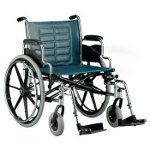 A wheelchair is probably one of the most recognized types of home medical equipment and dates back much further than other types of medical equipment. However, even though the history of the wheelchair, can be traced back many thousands of years, the modern wheelchair has roots that are much much younger.
A wheelchair is probably one of the most recognized types of home medical equipment and dates back much further than other types of medical equipment. However, even though the history of the wheelchair, can be traced back many thousands of years, the modern wheelchair has roots that are much much younger.
Manual Wheelchairs
Today, most manual wheelchairs feature a folding frame that is made out of lightweight hollow metal tubes. The seat has traditionally been made out of vinyl that is sewn around the wheelchair frame, although many newer wheelchairs incorporate improved padding and support. To allow the wheelchair user to self-propel, a manual wheelchair has large real wheels with metal hand-rims attached to the outside of the wheel.
The handrims allow the user to spin the wheels freely and easily, without making contact with the part of the tire that actually touches the ground. The front wheels are much smaller and are on pivots that allow the wheelchair to be turned simply by pushing it in a certain direction or by applying more pressure to one of the handrims.
These modern manual wheelchairs vary slightly in features, with some offering things like adjustable axles or different types of front rigging, which is the place at the front of the wheelchair where the user places their foot. However, the basic design is based on the Everest and Jenning’s Wheelchair(E&J Wheelchair) that was developed during the 1930′s. At this time, most wheelchairs where made out of a combination of wood and wicker, making them extraordinarily difficult to transport and also very hard to self-propel. Two inventors, named Everest and Jenning, set out to build a wheelchair that could be easily moved from place to place and also used without the help of a caretaker, creating a wheelchair frame whose influence can still be seen today in virtually all types of manual wheelchairs.
The manual wheelchair remains the most common type of wheelchair, with many people now opting to use a sports wheelchair, which is typically smaller and offers a number of performance improvements, but electric wheelchairs are also quite popular. Electric wheelchairs are much more expensive than manual wheelchairs, but since the device is powered by an electric motor, it requires little effort on the part of the user, aside from pushing the hand control in the desired direction.
Electric Wheelchairs and Power Chairs
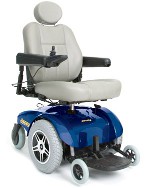 Electric wheelchairs come in a number of different shapes and sizes, as well as offering a number of different control methods, but the joystick control remains the most common. The joystick is mounted to one of the armrests of the wheelchair, allowing for either left hand or right hand use, with the wheelchair users simply pushing the joystick in the direction they wish to travel. For people with limited upper-body strength, a manual wheelchair is often too difficult to use, requiring a great deal of effort, which is the reason many people opt for an electric wheelchair, or power chair.
Electric wheelchairs come in a number of different shapes and sizes, as well as offering a number of different control methods, but the joystick control remains the most common. The joystick is mounted to one of the armrests of the wheelchair, allowing for either left hand or right hand use, with the wheelchair users simply pushing the joystick in the direction they wish to travel. For people with limited upper-body strength, a manual wheelchair is often too difficult to use, requiring a great deal of effort, which is the reason many people opt for an electric wheelchair, or power chair.
For those who are unable to use the joystick control, a number of alternate wheelchair controls are also available. One of the earliest alternate controls, which was first developed around the same time as the first electric wheelchair during the 1950′s, relies on head movements to steer the wheelchair. There are also remote controls available for caretakers, as well as a variety of much more advanced systems, including those that allow the power chair to be controlled by the breath of the user.
Wheelchairs continue to be one of the most common and well known types of home medical equipment, offering a way of improving accessibility. While power chairs are very convenient and easy to use, they tend to cost a lot more than manual wheelchairs, which can typically be found both new and used for at least a thousand dollars less than a power chair.
What Are Manual Wheelchairs and Why Are They So Popular?
Tuesday, April 13th, 2010
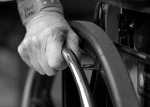 Choosing the best type of wheelchair is something that often comes down to personal preference, although there are certainly a number of other factors involved in this decision, such as physical capabilities and cost. For many, despite the allure of an electric wheelchair, even those heavy duty models that can be driven almost anywhere, a manual wheelchair is still the first choice.
Choosing the best type of wheelchair is something that often comes down to personal preference, although there are certainly a number of other factors involved in this decision, such as physical capabilities and cost. For many, despite the allure of an electric wheelchair, even those heavy duty models that can be driven almost anywhere, a manual wheelchair is still the first choice.
Manual wheelchairs have been used for thousands of years, but the modern design used today is based off of a 1930′s wheelchair called the E&J Wheelchair, developed by Everest and Jennings, two inventors. While there have been many improvements to the manual wheelchair since then, including improved metal working techniques and axle technology, the basic design is quite similar to these early models, which features a hollow metal frame to reduce weight, as well as allowing the wheelchair to be folded when not in use.
A lot of physical effort is required to use a manual wheelchair, which is propelled by the user who pushes on the large rear wheels. A set of hand-rims extends from the wheel, which allows the wheels to be spun easily, without having to touch the part of the wheel that makes contact with the ground. Of course, while many people choose to self propel their manual wheelchair, most also have push handles on the back, so the wheelchair can be pushed from behind.
The front rigging of the wheelchair is the part where the user rests their feet and typically provides two foot rests, although some provide only a single long foot rest, which can be folded up or removed quite easily. A set of parking brakes is also usually attached to the larger rear wheels, which work by simply applying pressure to the wheel and lock in place, holding the wheelchair still.
One of the main improvements to the original E&J Wheelchair has been to the rear axle. The axle connects the two rear wheels, allowing them to spin in unison and makes it possible to move the wheelchair easily in a straight direction, as well as making turning easier. Not only has the axle itself been improved mechanically, but many wheelchairs now offer a movable axle, which allows the user to change the weight distribution of the wheelchair, as well as reducing or increasing resistance.
Of course, cost often also plays a factor, as manual wheelchairs are much less expensive than electric wheelchairs.
A Quick Look At Sports Wheelchairs
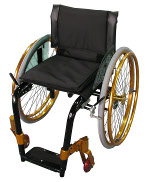 There are many types of manual wheelchairs and one type that has become quite popular in the last 10 or 20 years is the sports wheelchair. Sports wheelchairs come in a variety of designs and styles, including many specialized wheelchairs designed for specific wheelchair sports.
There are many types of manual wheelchairs and one type that has become quite popular in the last 10 or 20 years is the sports wheelchair. Sports wheelchairs come in a variety of designs and styles, including many specialized wheelchairs designed for specific wheelchair sports.
For example, sport wheelchairs designed for wheelchair racing have a very long wheelbase, with the front wheels extending several feet from the rest of the wheelchair, helping to improve stability. Wheelchairs designed for wheelchair basketball, on the other hand, typically have a special metal guard around the chair to protect the user.
Of course, sports wheelchairs do not always have such a glaringly different design and many are simply designed to be as light as possible, while including mechanical upgrades to improve performance. Often, they will feature a more comfortable seat that is made out of a very breathable material, as opposed to the vinyl often used in manual wheelchairs, as well as a lower back or even no back at all. Many find that sports wheelchairs are more practical, even though they don’t play a particular sport.
For instance, for those that work indoors, the lower backrest found on most sports wheelchairs makes it much easier to turn and work around a desk without being inhibited. So, it is common for people to prefer a sports wheelchair over a standard design.
Evaluating a Manual Wheelchair for Safety and Comfort
Monday, July 6th, 2009
 When ordering a new wheelchair, ensuring that the wheelchair fits the physical requirements of its user is very important for health and safety reasons, but it can also effect mental health.
When ordering a new wheelchair, ensuring that the wheelchair fits the physical requirements of its user is very important for health and safety reasons, but it can also effect mental health.
Ordering a wheelchair is not a decision that should be taken lightly and it is important that the wheelchair user has plenty of input during the process. Once a wheelchair has been ordered, it should constantly be reevaluated to ensure that it is safely meeting the needs of its user. This should be done both the wheelchair user, as well as a doctor.
Once a persons new wheelchair arrives, the prescribing doctor should evaluate the wheelchair to unsure that it is a proper fit for its user. There are a number of adjustments that can be made to the frame to fine-tune the wheelchair, so that the user can gain the maximum mechanical benefit from the wheelchair.
For manual wheelchairs, since they require a good deal of upper body strength to use, the comfort of the arms in relation to the manual wheelchairs drive wheels is very important. This means, that when in the starting position, the users arms should basically be at rest. This will help to prevent cramps and reduce the effort required to use the wheelchair.
The cushion and seat of the wheelchair should also be treated as a single unit, otherwise, you risk the user being too high or low when the cushion is added. Proper seat height is important, because if the wheelchair is too high, not only will it be uncomfortable, but it will also reduce the efficiency of the wheelchair, which makes it much harder to use. If the seat is too low, it can cause uneven weight distribution.
The height of the backrest is also very important. If it is too high, it can restrict the movements of the shoulder and upper body. However, a backrest that is too low will not provide enough support and can result in poor posture.
The overall width of the wheelchair is another important consideration, because a wheelchair that is too wide can result in the user developing poor posture. This is because the individual will have to lean side to side to reach the wheels. Of course, a wheelchair that is too narrow can cause discomfort and sores, so finding the correct median is essential.
A seat that is too deep can also cause problems, as it can reduce circulation and attribute to poor posture. It can also be dangerous, because the weight of the user is not as evenly distributed, resulting in less weight on the thighs.
Sports Wheelchair Parts Diagram
Tuesday, June 23rd, 2009
There are a great number of wheelchairs on the market and it is very important to find one that will fit the needs of its user. The sport wheelchair, or ultralight wheelchair, is very popular, both by people who are very active and those who simply find it easier and more comfortable to use.
*Please Note that some of the items below are not present in the picture, because they are not usually found on a sports wheelchair.
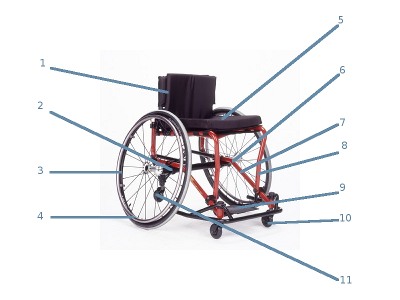
- Backrest
- Rear Axle
- Rear Wheels
- Handrims
- Seat
- Frame
- Traverse Bar
- Front Rigging
- Footrests
- Front Casters
- Anti-Tip Casters
- Brakes
- Tipping Levers
- Seatbelts
- Push Handles
- Upholstry
- Armrests
- Metal Skirt
1. Backrest: The backrest of a sports wheelchair is usually lower than a conventional wheelchair. Typically the backrest will be between 11†and 15â€. The backrest is also usually adjustable and models are also available that span 7†to 11†and 15†to 19â€. A lower backrest can allow for increased upper body movement.
2. Rear Axle: While on a conventional wheelchair, the axle is located directly below the backrest, many sports wheelchairs have adjustable axles. They can be positioned closer to the front of the chair, reducing the wheelbase and making the wheelchair more maneuverable. While typically much more maneuverable and easier to push, a smaller wheelbase also reduces the stability of the wheelchair. To increase stability, at the expense of maneuverability, the axle can be moved backwards towards the rear of the wheelchair. It also makes it a little harder to push, but increase the power of the stroke. Instead of a moving axle, some sports wheelchairs have a moving seat instead.
3. Rear Wheels: The rear wheels are usually the same size as on conventional wheelchairs, but sometimes for racing larger wheels are used. They feature sealed precision bearings and are designed to be as lightweight as possible. This makes the wheelchair easier to move and reduces friction. They also usually feature a quick release button, so the axle can be moved or wheel replaced quickly and easily. Most use spoked wheels, although some sports wheelchairs have solid molded rims.
Typically pneumatic tires are used, often allowing for a much higher pressure than traditional pneumatic tires. Pneumatic tires are great for outdoors, because they provide better shock absorption outdoors. Like racing bikes, the tires are often very narrow.
Often, the camber of the wheel, its angle, is often adjusted, much like you would adjust a sports car, with the bottom of the wheel farther out than the top. This brings the wheels closer to the users body, allowing for more energy efficiency. A wider wheelbase also offers the advantage of a more stable wheelchair that is also easier to steer.
This can pose a problem when indoors when dealing with narrow doorways and makes transporting the wheelchair more difficult. Some now allow the camber to be quickly adjusted to a “toe in†mode for indoor use though.
4. Handrims: The handrims are typically coated in foam that is covered in vinyl, although the rim itself is made of metal. This makes it easier to grab, however the vinyl can be very slick and result in finger burns. More or less padding can also be added, to deliver a variety of grip sizes.
Often smaller handrims are used, which require more energy to get started, but allow for a higher top speed. The smaller handrims also allow for the individual to maintain their speed easier. In many regards the size of the handrim is much like the different gears on a bike.
Sometimes for those with very limited upper body strength or mobility, small extensions are added to the handrail, which extend away from the wheelchair at an angle, making the wheels easier to turn.
5. Seat: The seat often has pieces of velcro attached to it, allowing cushions and bags to be attached. The lower backrest of the seat allows for a greater range of movement and slightly elevates the knees, improving stability.
6. Frame: The frame of a sports wheelchair is made of metals that are very lightweight, such as aluminum, titanium, and graphite. Often, the entire wheelchair will weigh only 25 pounds, which is about half of what a conventional wheelchair weights. There are some, however, that can weigh as little as 15 pounds. The lighter the frame, the easier it is to propel.
Traditionally the frame of sports wheelchairs had been rigid. This improved its performance and made it much sturdier, but it also made it harder to transport. The seat would have to be folded forward and the larger rear wheels would be removed. However, as of late, several manufacturers have begun making folding sports wheelchairs, which makes transportation much easier.
7. Traverse bar: The traverse bar replaces the crossbars found on conventional wheelchairs and helps make the frame sturdier. On folding sports wheelchairs, the frames are equipped with locks to prevent it from folding unless needed.
8. Front Rigging: The front rigging refers to the footrest and the bars that connect it to the frame. Traditionally, the front rigging was not detachable, which improved the stability of the frame. However, this could make transferring into and out of the chair more difficult, some some sports wheelchairs now feature detachable and swing away front rigging.
9. Footrests: The footrest is typically one piece and made of several metal tubes, instead of a platform. It is usually closer to the frame than conventional wheelchairs, reducing the sports wheelchairs turning radius.
10. Front Casters: The front casters are typically made out of solid polyurethane, although some use pneumatic or solid rubber tires. The casters are smaller than those on a conventional wheelchair, usually only 4†to 5†in diameter. However, on racing wheelchairs larger front casters are often used.
11. Anti-Tip Casters: Anti-Tip casters prevent the wheelchair from tipping backwards completely and are often not included on newer wheelchairs.
12. Brakes: Most sports wheelchairs do not have brakes, although some choose to use them. If used, scissor brakes are most popular and mounted lower down on the frame, so the users hand does not become entangled when pushing or the brake accidentally activated. (Not Pictured)
13. Tipping Levers: Typically the tipping lever, which makes it easier for someone pushing the wheelchair to tip the wheelchair backwards and navigate curbs, are much smaller than those on conventional wheelchairs. (Not Pictured)
14. Seatbelts: Seatbelts are usually available for most sports wheelchairs as an option. Some wheelchair users that are very active will use a safety harness to provide more support. (Not Pictured)
15. Push Handles: Many sports wheelchairs do not have push handles, because of the added weight. Instead, fabric straps are added to the back of the seat, to provide a handhold. Some, however, do have push handles. (Not Pictured)
16. Upholstry: Most sports wheelchairs have reinforced nylon or darcon upholstry. This is very lightweight and strong, but unlike vinyl, it is not as easy to clear. (Not Pictured)
17. Armrests: Most sports wheelchairs do not have armrest, which reduces the weight, while allowing the user a better pushing angle. It also increases the users range of upper body movement. (Not Pictured)
If armrests are present, they are usually lightweight and removable. Typically they are not strong enough for the user to use them to transfer into and out of the wheelchair.
18. Metal Skirt: A metal skirt is also usually not present, for both wheelchairs with and without armrests, so the user will risk dirtying their clothes or catching them in the wheels. (Not Pictured)
Other Types of Sports Wheelchairs
There are many different popular wheelchair sports and almost all of these types of sports use a slightly different wheelchair design. For example, the footrest and front rigging of a wheelchair that will be used for wheelchair basketball has a built in foot guard to add more protection. Wheelchairs for wheelchair rugby have an even more protective front guard, as well as more protection around the wheels.
Wheelchairs that are used for racing are elongated to provide stability, so the front wheels often extend several feet from the wheelchairs seat. Since there is so much diversity among the design of sports wheelchair, it is important to decide what you want to use the wheelchair for and to speak with a professional or other wheelchair user to determine what type of wheelchair will be best. It is also not uncommon for many wheelchair users to prefer the design of a sports wheelchair, even if they do not intend to directly use it to play sports.
Manual Wheelchair Parts Diagram
Monday, April 20th, 2009
Today, there are a number of different wheelchairs available, but the most common is the steel framed wheelchair. This type of manual wheelchair shares the E & J design, which was developed over eighty years ago, and is the type found in most hospitals. They are also referred to as Traditional wheelchairs, standard wheelchairs, or Conventional Wheelchairs.
Below, you will find a diagram of a traditional wheelchair and a list of its components. Click on any of the links to find out its description or you can scroll down the page.
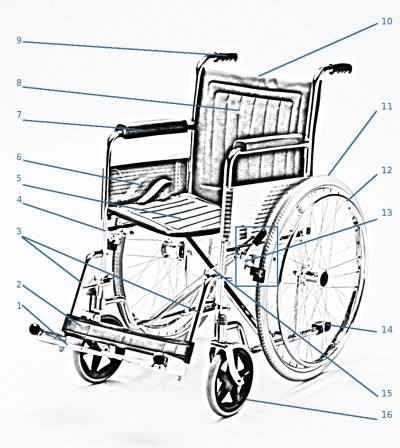
- Footrest
- Legrest
- Front Rigging
- Frame
- Seat
- Metal Skirt
- Armrests
- Backrest
- Push Handles
- Push Axle
- Rear Wheels
- Handrims
- Brakes
- Tipping Lever
- Crossbars
- Caster Wheels
- Anti-Tip Casters (Not Pictured)
1. Footrest: The footrests, which are also called footplates and footpedals, can be adjusted to accommodate different lengths and can also be rotated.
2. Legrest: The legrest extends from the front of the wheelchair and the footrest is attached to the legrest.
3. Front Rigging: The front rigging refers to the footrest arm and the legrest as a single unit. In most conventional wheelchairs, the front rigging can be removed, but this is not always the case in less expensive models. It can also often be elevated to provide an elevated leg rest.
4. Frame: The conventional wheelchairs frame is made out of cold rolled steel that is chrome plated. The frame is the heaviest part of the wheelchair and it can weigh up to 50 pounds, but a stainless steel frame is also available that weighs about ten pounds less.
5. Seat: The seat, like the other fabric parts of a conventional wheelchair, is made from vinyl and uses a sling design. Multiple colors are often available and the vinyl fabric makes it very easy to clean.
6. Metal Skirt: The metal skirt is installed on either side of a conventional wheelchair between the armrests. It is designed to protect the users clothes from dirt, moisture, and debris that can be kicked up by the wheels. Metal Skirts also prevent the users clothes from becoming caught in the wheelchair.
7. Armrests: There are two types of armrests: Full length and Desk Type. The armrests are secured to the frame in two places and are designed to be very sturdy.
8. Backrest: The Backrest height is fixed and typically is about 16 ½ inches high. However, reclining backrests and extending backrest are available as options for most conventional wheelchairs.
9. Push handles: The Push Handles are located on the back of the wheelchair and rubber handles are installed to make them more comfortable.
10. Push Axle: The Push Axle ensures provides support for the push handles and is at a fixed height.
11. Rear Wheels: Typically the rear wheels will be 24 inches in diameter. Both Pneumatic and Solid tires are used. The rear wheels are used for manual propulsion of the wheelchair.
12. Handrims: The handrims extend outwards from the rear wheel. They are typically chrome plated and are used to propel the wheelchair.
13. Brakes: The brakes are located on the large rear wheels. They are typically located on the front of the wheel next to the bottom of the seat.
14. Tipping Lever: The tipping lever extends from the bottom of the frame and is designed to make it easier to move the wheelchair over obstacles, such as curbs. The person pushing the wheelchair will put weight on the tipping lever, which causes the wheelchair to tip backwards.
15. Crossbars: The crossbars are located under the seat and allow the wheelchair to be easily folded for storage and transportation. There are typically no locks to keep the conventional wheelchair from folding, but instead the weight of the user prevents the wheelchair from being folded.
16. Caster Wheels: The wheels of a conventional wheelchair are called caster wheels and are typically 8 inches in diameter. They are typically made of solid rubber, but for outdoor use pneumatic tires are recommended.
17. Anti-Tip Casters (Not Pictured): Anti-Tip Casters are not always present on conventional wheelchairs, but they can usually be added. They are designed to prevent the wheelchair from tipping over backwards. In the event that the wheelchair tips over too far, the anti-tip casters make contact with the ground, preventing it from completely tipping over.
The conventional wheelchair remains one of the most popular and recognized type of manual wheelchairs available. They are often available in a number of different colors and many offer features to make them easier to use, such as removable armrests to make transferring into and out of the wheelchair easier. They can be seen in public areas, like hotels, airports, grocery stores, and hospitals, which offer wheelchairs for their patrons to use.